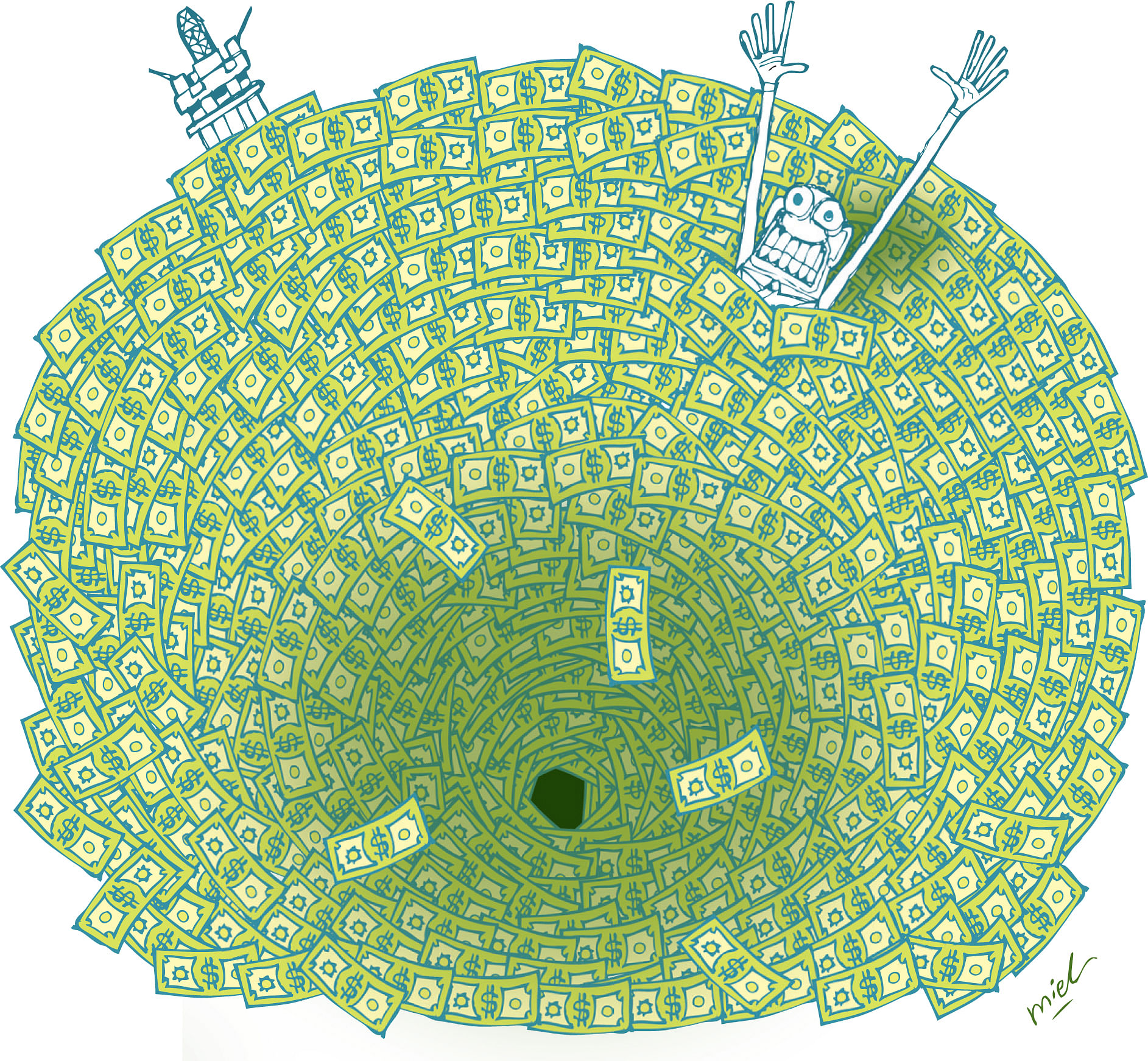Three weeks into the sudden collapse of Swiber Holdings - the first major casualty of a protracted slump in oil prices - concerns are emerging over possible spillover into the local economy as one-fifth of manufacturing employment is linked to the beleaguered offshore and marine (O&M) industry.
Economists warn that insolvencies of offshore service companies can potentially affect the country's gross domestic product (GDP) as the sector accounts for up to 11 per cent of manufacturing's contribution to GDP, and 20 per cent of manufacturing employment. Some 88,000 workers are in the O&M sector, and that is out of a manufacturing workforce of 421,000, according to the Economic Development Board's (EDB's) 2014 estimates. That figure has roughly doubled since 2002.
As more O&M companies downsize or go under, employment will take a direct hit, and those leasing to the industry may end up with vacant properties, and be stressed from mortgage servicing.
Rising provisions and write-offs may be on the cards. Singapore banks' loans to the offshore support service sector are at 2-3 per cent of total lending. In its latest second- quarter earnings report, OCBC recognised new non-performing assets (NPAs) of about $370 million for oil and gas exposure, while the bulk of UOB's $802 million new NPAs came from the sector.
FACTORS BEHIND SWIBER'S FALL
That the offshore sector has been struggling with historically depressed oil prices is not new. The protracted downturn had led to fewer projects, reduced profit margins due to intense competition among offshore service providers and collection difficulties.
But these industry woes were magnified in Swiber's case.

Its troubles worsened as a slowdown in existing projects due to the Indian monsoon season was compounded by a dearth of projects in South-east Asia. As banks started cutting their exposure to the oil and gas industry early last year when oil prices tanked, Swiber began facing difficulties raising new funds from debt and capital markets.
Compounding the nightmare, US$466 million (S$625 million) in revenues from several projects failed to materialise in the second quarter, and $205 million in note redemptions - money borrowed from bond holders - were due in June and last month.
This, and other factors resulting in a rapid deterioration in Swiber's finances in the second quarter, was what prompted it to step up its push for a deal with investor AMTC, which in turn led to a series of events triggering its collapse.
What catalysed Swiber's downfall was its decision to take two loans from its principal banker DBS - a US$85 million loan to redeem a S$130 million note due on June 6, and a US$61 million loan to redeem a S$75 million note due on July 6, observers said. This is especially after the security Swiber gave for the US$61 million loan effectively left it without any working capital.
But its collapse could have been delayed or averted had London private equity firm AMTC come through. On June 9, AMTC agreed to buy US$200 million of preference shares in the Swiber unit, Swiber Investment. This would have provided critical funds for the company to stay afloat. But AMTC's funds never came, despite repeated assurances. That proved to be the final nail in the coffin.
Now, industry observers are questioning how much pressure had been brought to bear on Swiber to take the loans to redeem the two bonds that were, to an extent, arranged by DBS. "Had the bonds been allowed to go into default, it would have had a knock-on effect on both DBS and Swiber, because their fortunes had become so intertwined," an observer said.
The sorry saga over Swiber has shaken the oil and gas, as well as banking, sectors to the core.
"The oil and gas sector needs to recalibrate, relook its business fundamentals, as oil prices aren't expected to recover quickly any time soon," an industry source said.
"The sector will survive, but it has to deal with its debt burdens, which were incurred mainly at a time when oil was more than US$100 a barrel. Seeing that the costs of extraction for offshore oil and gas can range between US$35 and US$75 a barrel, a relook at the business fundamentals is imperative when oil is now below US$50 a barrel ."
CONTAGION EFFECT
Even before Swiber's fall, the local O&M sector had already started seeing a shakeout as order books declined and contract deliveries were deferred or cancelled. A case in point: Otto Marine in June received a delisting offer for its shares. Technics Oil & Gas filed for judicial management and Linc Energy has gone into voluntary administration. Auditors for KS Energy, EMS Energy and RH Petrogas have expressed concerns over these companies as going concerns.
"With estimated total borrowings of $25 billion ($6.6 billion in bonds and $18.3 billion in bank borrowings) and with peak bond maturity in 2017, the risk is for more debt restructuring from issuers in the sector," Ms Kum Soek Ching, head of South-east Asia research and private banking research at Credit Suisse, warned.
"With over half the $18.3 billion sector bank borrowing from mid-sized service companies, Singapore banks could see loan losses rising, in contrast to the current reassuring narrative from management that asset quality remains stable," she added.
Swiber, now under judicial management after initially filing for liquidation, could start a restructuring of companies in the sector, Ms Kum said. "As all bonds are of small issue sizes, there is little secondary market liquidity after the news broke. Investors in these bonds now have to adopt a wait-and-see as bid prices have vanished. It is difficult to put a value on any liquidation of hard assets of Swiber in the current tough environment," she noted.
If more offshore marine companies follow in the footsteps of Swiber, this would further dent investor confidence in both equities and bonds.
"Bank loans growth has been in a slump for a period, reflecting drags from both general commerce and transport/storage and communications industries. The impact on the economy may not be easily quantifiable," said Ms Selena Ling, head of treasury research and strategy at OCBC Bank.
THE NEXT SWIBER?
Of the 19 Singapore-listed offshore service companies, 10 recorded net losses in the first quarter of this year, Moody's Investors Service noted. These accounted for more than 60 per cent of the total debt assumed by the 19 offshore service companies, it said.
There are 18 with notes due in 2016-2018, including KrisEnergy, Nam Cheong, Marco Polo Marine and AusGroup, and these could be at higher risk of default if exploration and production activities remain suppressed, according to CIMB Research.
As observers continue to watch for the "next Swiber", many oil and gas companies have already begun negotiating with banks to restructure their debts, and to have looser covenants.
"Only those that realise that oil prices could be 'lower for longer', and are cutting costs and finding new ways to deploy assets will survive," said Mr Kelly Chia, senior research analyst at Bank Julius Baer. "Companies hoping for a quick rebound and borrowing to invest even more, rather than cutting cost and waiting for the industry to turn around, could find themselves in trouble."
Swiber's abrupt collapse has caused banks to scrutinise more closely all their contracts with oil and gas firms. "Swiber is a lesson to not take things for granted. Banks are now double-checking on collateral against vessels, looking at payment terms, charter rates, project financing, and going through everything with a fine-tooth comb," an industry analyst said.
"While the banks are very well-capitalised, it is their near-term profitability that worries investors. They are questioning how conservative banks really are, how they classify non-performing loans, how good is their asset quality, and what is the potential of more bad debt," he noted.
RISING UNEMPLOYMENT
After the great financial crisis of 2008, rig builders suffered a dearth of orders in 2009 and 2010, but then rebounded very quickly from 2011 as oil prices surged to US$70 levels and helped them achieve high order books.
"The O&M industry weathered the financial crisis relatively well and the banks were comfortable with their positions then... We think what caught most of them by surprise (this time) was that they could not foresee oil prices staying so low for this long," Mr Chia said. This prolonged slump has led most oil majors to trim capital expenditure and cut costs last year and this year. As a result, the industry has suffered a significant drop in work.
Not surprisingly, O&M companies have been slashing headcount since 2014. Most are service support providers such as vessel charterers, engineering procurement and shipyards, and are dependent on oil majors' upstream activities.
Keppel alone has already trimmed 4,900 workers from its offshore marine division and 670 sub- contract staff in the first half, leaving them with 25,300 and 24,430 staff respectively, Ms Ling noted.
Credit analyst Nick Wong of OCBC Bank said: "What fat companies can cut has already occurred. Now they have to be careful to avoid cutting into muscle, which would hurt them when the cycle turns. I expect to see more cost-cutting, but at a more measured pace."
While the oil and gas sector accounts for just 5 or 6 per cent of overall GDP, economists said the knock-on effects for other sectors, including financial and banking services and manufacturing, are worrying.
"The banking sector is already in consolidation mode, with many foreign banks cutting down on regional activity due to risk aversion in financial markets, the slowdown in China, uncertainties in Europe after Brexit, and sluggish US growth. On top of this, there's the protracted slump in oil prices," DBS economist Irvin Seah noted.
When oil prices were high in 2007 and 2008, the manufacturing sector, particularly transport engineering (which includes aerospace, land transport and marine offshore engineering), was growing strongly.
"At its worst in December 2015, the O&M industry contracted by 42 per cent, an all-time low due to plunging oil prices. For the past few months, the industry has been contracting by 30 per cent on average, worse than the financial- crisis period when growth was con- tracting by 20 per cent for several months. At least the rig builders still had healthy order books during the financial crisis," Mr Seah noted.
Given current conditions and global economic uncertainty, and the likelihood that oil prices will remain moribund in the near term, the roller-coaster ride post-Swiber seems far from over.

